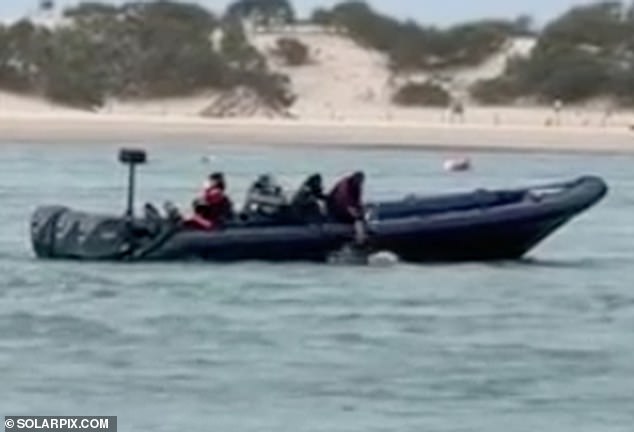- You can clearly see smugglers pushing migrants off the boat into the current
This is the horrific moment people smugglers drove migrants into the raging currents off a Spanish beach and sped away – just minutes after leaving four North African teenagers to drown nearby.
Footage showed the group being forced into a canal of choppy waters off Sancti Petri, near the city of Cadiz, by the gang aboard a powerful semi-rigid Zodiac – a vessel normally used by drug smugglers.
Survivors said last night that smugglers had threatened them with knives and even guns to jump into the freezing and treacherous water.
Yesterday around 1pm, Spanish Good Samaritan workers rushed to rescue the migrants.
It came after a large group had recently been left to their fate on Camposoto beach, one of the longest in southern Spain and a 20-minute drive from Cadiz, where four young migrants who were believed to be unable to swim drowned.

Footage showed the migrants being forced into the choppy waters by the gang aboard a powerful semi-rigid inflatable boat

This is the sickening moment people smugglers push migrants into rip currents off a Spanish beach

Migrants swim desperately to shore after being pushed off the boat

Spanish Good Samaritans care for the migrants after rescuing them from troubled waters
Witness and rescuer Javier Gomez, owner of a water sports company based in the resort of Costa de la Luz, said: “We have never seen anything so hideous.”
He added that some of the migrants were lying semi-conscious and face down in the water as he pulled them into a small boat.
Describing the “terrible” experience as one he would never forget, he told the Spanish press: “One of the survivors told us that they threatened him with a gun and said to him: ‘Jump, otherwise we will shoot you “Bullet in the head'”.
“Those who were able to talk after we helped them ashore thanked us.” They were all young, between about 15 and 20 years old. They said they paid 5,000 euros (£4,500) for the trip.”
It is believed that many of those who ended up in the water during the two drops were novice swimmers or non-swimmers. T
They were also fully clothed, which would have made it more difficult to get to land.
The people smugglers simply sped away from the scene while the migrants fought the currents.
Three of the survivors were evacuated by ambulance and taken to a hospital in Puerto Real, near Cadiz, suffering from hypothermia.
Police are still on the hunt for the people smugglers, whose nationality is not known.
If caught, they could face criminal charges up to and including manslaughter.
Cadiz is located on the southern tip of Spain, about 20 km (12 miles) from the North African coast.
Despite its proximity, the Cadiz area is not a common destination for migration routes from the Maghreb as it is located on the Atlantic coast, where sea conditions are more complicated and there is a lot of surveillance in the Strait of Gibraltar.

Three of the survivors were evacuated by ambulance and taken to a hospital in Puerto Real, near Cadiz, suffering from hypothermia
However, Spain remains one of the main entry points for migrants into Europe, particularly via the western Mediterranean, with boats departing from Morocco and Algeria.
Over 13,000 such migrants arrived in mainland Spain or the Balearic archipelago between January 1 and November 15, 11.5 percent more than in the same period last year, according to the latest figures from the Spanish Interior Ministry.
According to the European agency Frontex, Moroccans make up almost half of the people who choose this migration route.

